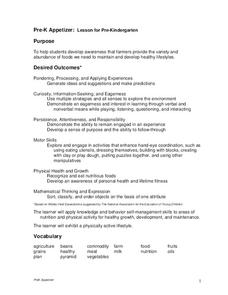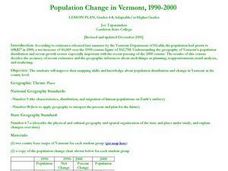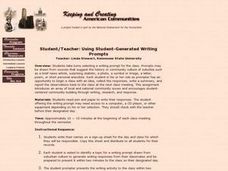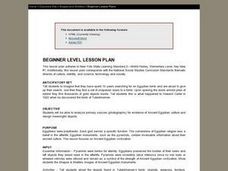National First Ladies' Library
Colonial America: The Original 13
Middle schoolers work in small groups to research the initial history of two colonies and answering a list of questions. They then prepare a PowerPoint presentation or poster that includes all the findings of the questions and share...
Curated OER
Exploring Arrangements of 2, 3, 4, and 5 Cubes
Students use problem solving skills to create various models of tricubes, tetracubes, and pentacubes. They classify the cubes into various groupings and identify them as mirror images, regular arrangements, and irregular arrangements....
Curated OER
Pre-K Appetizer
Students understand there are healthy and not healthy food choices. In this food pyramid lesson, students learn to make healthy choices by playing a traffic light game. Students recognize raw foods from the farm may not be ready for...
Curated OER
Where In the World Are We?
Fifth graders read postcards and find their locations on maps. They use the pictures and text on the postcards to write about imaginary vacations. They compute the mileage and compare it to TripMaker data.
Curated OER
Creating Scrolls Based on the illustrated TALE OF GENJI
Students identify formal elements that characterize the scroll, work in a variety of media, from traditional to digital, to create their own scrolls, work into digital printout with at least two media, and engage in meaningful critiques...
Curated OER
Reading distance on maps
Eighth graders complete worksheets on reading the distance on maps in miles or kilometers. In this maps lesson plan, 8th graders use a calculator and ruler.
Curated OER
Urban Planning: Plan a City
Pupils analyze the concept of urbanization by planning the placement of some of the major urban/suburban features that make up most cities. They arrange the cultural features to benefit the people who live there, and maintain respect for...
Curated OER
Population Change in Vermont, 1990-2000
Students improve their mapping skills and knowledge about population distribution and change in Vermont at the county level. They are divided into groups of two or four. Each group is given two county base maps and the population...
Curated OER
Punch Mix-up
Fifth graders discuss the relationship between equivalent fractions, ratios, and proportions. In this fraction lesson, 5th graders answer questions about a punch mixture in order to find the ratio of ingredients.
Curated OER
Should Hate Be Outlawed?
Students investigate hate crime legislation. In this hate crime instructional activity, students examine the St. Paul city ordinance that outlawed hate crimes. Students explore the fine between hate crime legislation and First...
Curated OER
Using Logos and Mission Statements to Communicate Sustainable Forestry Information
Young scholars survey forestry foundations to see how they represent important information into their logos and mission statements. In this forestry lesson plan, students use the information to better understand visual representations...
Curated OER
Cartoon Analysis Worksheet Key Jay’s Treaty
In this primary source analysis worksheet, students examine a political cartoon about Jay's Treaty and then respond to 10 analysis questions about the cartoons they select. The cartoon is not included and answers to each of the questions...
Curated OER
Respect
Students define what having respect or showing respect means. They distinguish between a respectful and a disrespectful situation. They role-play examples of showing respect and disrespect to others.
Curated OER
Student/Teacher: Using Student-Generated Writing Prompts
Students select writing prompts for the class.
Curated OER
Weather and Climate
Students identify the words plain and climate and discuss what would happen if it never rained. Students identify and interpret the weather in Poland and create a web illustrating various weather patterns. Students write a 4-line poem...
Curated OER
Ode to a Nightingale
High schoolers read poems about Tuberculosis by John Keats. Using the poems, they identify similies, metaphors, personification and imagery. In groups, they make connections about the author's outlook on life and how his disease...
Curated OER
Shapes and Shelters
Young scholars are be able to analyze primary sources (photographs) for evidence of Ancient Egyptian culture and design meaningful objects. They are grouped in pairs and instructed to choose someone that they admire, either living or...
Curated OER
Coast-to-Coast Book Design-Part 3: Brainstorming the Book
Students examine the process of designing a book and identify the steps necessary to publish a book. In small groups they analyze ABC books, and discuss the similarities and differences between the books. Students then brainstorm ideas...
Curated OER
Coast-to-Coast Book Design-Part 4: Let's Create the Pages!
Students work in groups to share their lists of A-B-C ideas they came up with from the previous activity. They review page layouts taught during instructional activity two. Students complete a rough draft of their page. They create a...
Curated OER
Canadian Crossword
In this crossword puzzle worksheet, students read 8 clues about Canadian locations on the map and the culture of Canadian people. This would be difficult for U.S. students, as there is no word bank.
Curated OER
Class of Cards
Young scholars create patterns using images of everyday objects, shapes, or colors and four logos for use in a House of Cards. In this design lesson, students examine the work of Charles and Ray Eames and become familiar with the...
Curated OER
Tales From the Crypt
Eighth graders study the people of their community. In this Geography lesson, 8th graders research local history using maps and books. Students create a timeline of tombstones for deceased residents.
Curated OER
Spatial Connections
Students use maps, scales, and describe locations in order to learn about spatial sense. In this spatial sense lesson plan, students participate in many activities for this spatial sense unit that should last throughout the year.
Curated OER
American Indian Art
Students complete a unit of study about Native American visual art. In this visual art lesson, students complete five lessons to study Native American art.

























